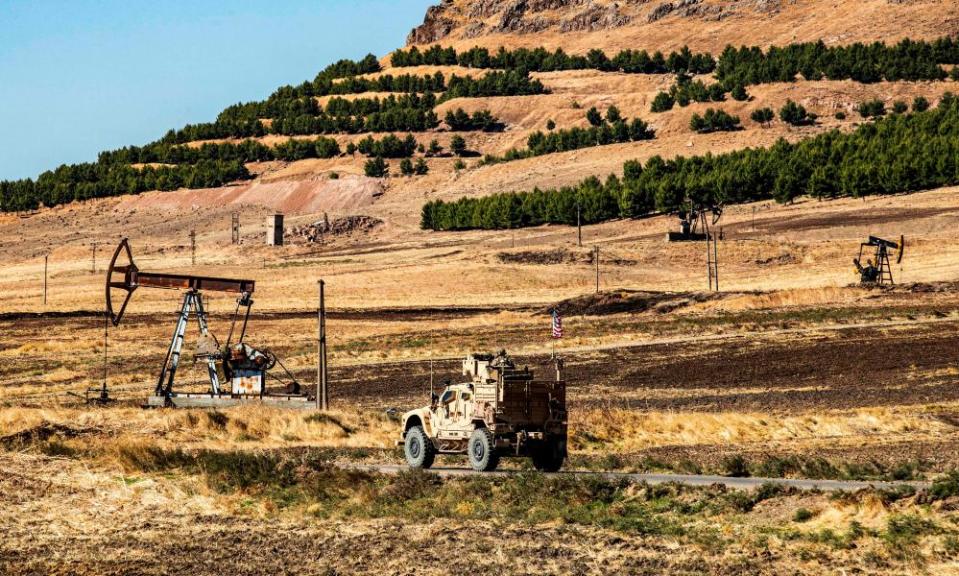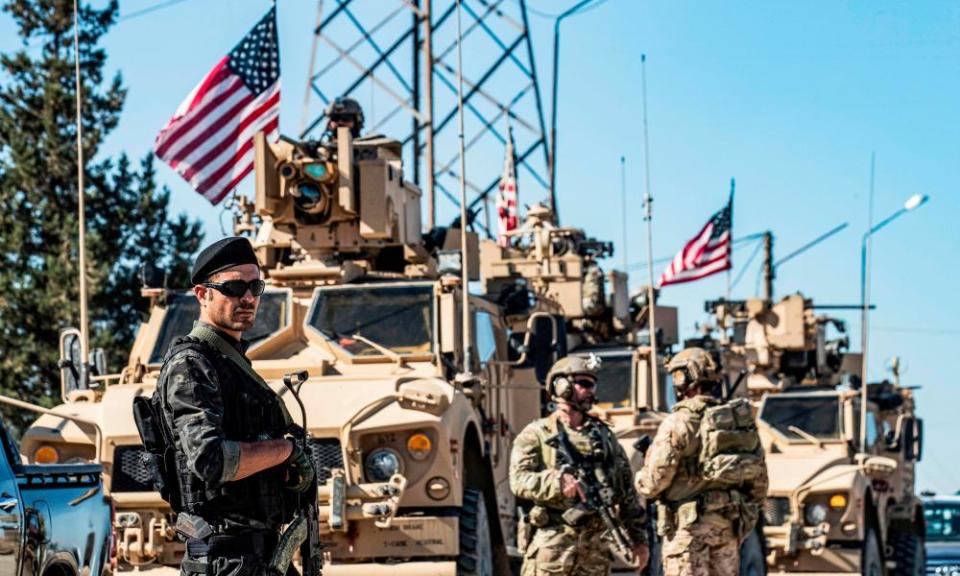'Secure the oil': Trump's Syria strategy leaves Pentagon perplexed
US officials are struggling to explain the mission of up to a thousand US troops in Syria, who have mostly taken up positions near oil fields in response to Donald Trump’s orders.
A fortnight after ordering a complete evacuation of US troops ahead of a Turkish incursion into northeastern Syria, abandoning Kurdish partners in the fight against Isis, Trump changed his mind and said some forces should stay but only to “secure the oil”.
So as hundreds US special forces are being flown out of Syria, hundreds of other soldiers, equipped with armoured vehicles, have been driving into the region, heading for small-scale oil patches Der Ezzor and Hasakah provinces, but without a clear idea of what they were supposed to do there.
I like oil. We’re keeping the oil
Donald Trump
The unease of US officials implementing the policy became apparent on Thursday when an internal report by the top US diplomat in northern Syria, William Roebuck, was leaked to the New York Times. In the report, Roebuck complains that “we didn’t try” to deter the Turkish incursion, which has killed hundreds of civilians and displaced hundreds of thousands.
Who is in control in north-eastern Syria?
Until Turkey launched its offensive there on 9 October, the region was controlled by the Syrian Democratic Forces (SDF), which comprises militia groups representing a range of ethnicities, though its backbone is Kurdish.
Since the Turkish incursion, the SDF has lost much of its territory and appears to be losing its grip on key cities. On 13 October, Kurdish leaders agreed to allow Syrian regime forces to enter some cities to protect them from being captured by Turkey and its allies. The deal effectively hands over control of huge swathes of the region to Damascus.
That leaves north-eastern Syria divided between Syrian regime forces, Syrian opposition militia and their Turkish allies, and areas still held by the SDF – for now.
On 17 October Turkish president, Recep Tayyip Erdoğan, agreed with US vice-president Mike Pence, to suspend Ankara’s operation for five days in order to allow Kurdish troops to withdraw. The following week, on 22 October, Erdoğan and his Russian counterpart, Vladimir Putin agreed on the parameters of the proposed Turkish “safe zone” in Syria.
How did the SDF come to control the region?
Before the SDF was formed in 2015, the Kurds had created their own militias who mobilised during the Syrian civil war to defend Kurdish cities and villages and carve out what they hoped would eventually at least become a semi-autonomous province.
In late 2014, the Kurds were struggling to fend off an Islamic State siege of Kobane, a major city under their control. With US support, including arms and airstrikes, the Kurds managed to beat back Isis and went on to win a string of victories against the radical militant group. Along the way the fighters absorbed non-Kurdish groups, changed their name to the SDF and grew to include 60,000 soldiers.
Why does Turkey oppose the Kurds?
For years, Turkey has watched the growing ties between the US and SDF with alarm. Significant numbers of the Kurds in the SDF were also members of the People’s Protection Units (YPG), an offshoot of the Kurdistan Workers’ party (PKK) that has fought an insurgency against the Turkish state for more than 35 years in which as many as 40,000 people have died. The PKK initially called for independence and now demands greater autonomy for Kurds inside Turkey.
Turkey claims the PKK has continued to wage war on the Turkish state, even as it has assisted in the fight against Isis. The PKK is listed as a terrorist group by Turkey, the US, the UK, Nato and others and this has proved awkward for the US and its allies, who have chosen to downplay the SDF’s links to the PKK, preferring to focus on their shared objective of defeating Isis.
What are Turkey’s objectives on its southern border?
Turkey aims firstly to push the SDF away from its border, creating a 20-mile (32km) buffer zone that would have been jointly patrolled by Turkish and US troops until Trump’s recent announcement that American soldiers would withdraw from the region.
Erdoğan has also said he would seek to relocate more than 1 million Syrian refugees in this “safe zone”, both removing them from his country (where their presence has started to create a backlash) and complicating the demographic mix in what he fears could become an autonomous Kurdish state on his border.
How would a Turkish incursion impact on Isis?
Nearly 11,000 Isis fighters, including almost 2,000 foreigners, and tens of thousands of their wives and children, are being held in detention camps and hastily fortified prisons across north-eastern Syria.
SDF leaders have warned they cannot guarantee the security of these prisoners if they are forced to redeploy their forces to the frontlines of a war against Turkey. They also fear Isis could use the chaos of war to mount attacks to free their fighters or reclaim territory.
On 11 October, it was reported that at least five detained Isis fighters had escaped a prison in the region. Two days later, 750 foreign women affiliated to Isis and their children managed to break out of a secure annex in the Ain Issa camp for displaced people, according to SDF officials.
It is unclear which detention sites the SDF still controls and the status of the prisoners inside.
“US policy in eastern Syria these days seems to be an attempt at building a plane already in flight,” Kayleigh Thomas, research associate for the Middle East Security programme at the Centre for a New American Security (CNAS), said.
“For example, if Syrian government forces were to attack, would [US troops] then respond in self-defence? It looks like some of those legal questions are still being hashed out.”
The mission initially sounded straightforward as Trump presented it.

“We want to bring our soldiers home. But we did leave soldiers because we’re keeping the oil,” he said on 1 November. “I like oil. We’re keeping the oil.”
The president suggested that taking possession of Syrian natural resources would be fair “reimbursement” for the cost of going to war there.
The problem for military planners is such pillage of a foreign country is a violation of the laws of war as applied in the Nuremberg trials and commonly accepted since.
It could also violate the Authorisation for Use of Military Force granted by Congress to the US government in the immediate wake of the 9/11 attacks, intended for operations against al-Qaida and “associated forces”, which has been used to justify armed intervention across the Middle East.
The Pentagon sought to bring clarity on Thursday, by insisting that the mission was unchanged, and that US troops were in Syria solely to defeat Isis in partnership with the Kurdish-led Syrian Democratic Forces (SDF).
“The securing of the oil fields is a subordinate task to that mission. And the purpose of that task is to deny ISIS, the revenues from that oil, infrastructure,” Rear Admiral William Byrne, the vice director of the joint staff, told reporters. “I’m not sure Isis is going away yet. And that’s why we’re there: to help them go away.”

He added that the US would continue to arm the SDF, who are currently in conflict with Turkey, a Nato ally.
“We’re still going to provide them with the support and ability to ... continue the fight against Isis,” Byrne said, describing the relationship with the Kurdish-led force as “shoulder to shoulder”, a phrase he repeated four times..
Related: Trump's Turkey deal hands power to Ankara and leaves Syrian Kurds for dead
The Pentagon spokesman, Jonathan Hoffman, said part the aim of deploying troops to the oil fields was to ensure that any revenues from their production would go to the SDF.
The new talking points stress continuity and present an argument for the legality of the deployment, but they directly contradict the president. Apart from his continued insistence that the US should benefit from the oil, Trump has declared that Isis is totally or “largely” defeated, particularly after the killing of its leader Abu Bakr al-Baghdadi, and that taking care of the remnants was a job for someone else.
Charles Lister, a Syria expert at the Middle East Institute said that some of the confusion stems from the internal dynamics of the administration in which senior policy-makers, like Syria envoy, James Jeffrey, have exploited Trump’s obsession with oil to achieve other objectives.
“The whole oil thing is by and large a ploy to get presidential support to hold together a US presence, to shore up relations with the SDF and the tribes in the east who have been anti-regime and anti-Iran,” Lister said.
Nicholas Heras, an analyst on the CNAS Middle East programme, said the real reason for sending mechanised US units to the eastern oilfields is to keep the oil out of the hands of the Assad regime and its Russian backers.
“To counter Isis you need lighter, more agile forces,” Heras said. With winter coming, and the regime increasing desperate for energy supplies, control of the oil supply maintains some leverage in the region. In February 2018, US forces fought an intense battle with regime-backed militiamen and Russian mercenaries around a gas plant outside Deir Ezzor city.
Related: General discontent: how the president's military men turned on Trump
The defence secretary, Mark Esper has suggested that one of missions of US troops would be to continue to deny access to the oil to the regime and Russia. The Pentagon sought to play that down on Thursday, focusing on a potential Isis threat, but Hoffman said that US troops would defend themselves against any attackers.
“Everyone in the region knows where American forces are,” the spokesman said. “We work to ensure that no one approaches or has hostile intent to our forces. And if they do our commanders maintain the right of self defense.”

The contradictions and uncertainties underlying the US presence are likely to come to the fore in the next few days, as Turkish, Syrian regime and Russian troops move into previously SDF-run areas and as the Turkish president, Recep Tayyip Erdoğan, visits the White House.
At Thursday’s Pentagon briefing, Byrne insisted the ceasefire negotiated in northeastern Syria was holding apart from “relatively small skirmishes”.
However, Turkish-backed Arab militias are reported to be pushing towards the town of Tal Tamr, which is outside the zone Kurdish forces agreed to withdraw from.
Steve Gumaer, the head of the Partners Relief & Development aid organisation, who was in Tel Tamr last week said the current front was only 4km north of the town.
“All the time we were there has been non-stop fighting. People are being killed and injured every day,” Gumaer said.
Related: Syria: videos of Turkey-backed militias show 'potential war crimes'
A senior administration official expressed concern about the possibility that the militias involved around Tal Tamr were not under Ankara’s full control.
“It’s basically these Turkish-supported Syrian Arab militias that are in there,” the official said. “And we were very concerned because they were seemingly heading towards the city of Tal Tamr, which is a relatively large Christian area, which everybody acknowledges is outside of [the agreed Turkish zone].”
“The problem is that the people doing the fighting are these ill-disciplined Arab militias, some of whom we’ve worked with in the past when we were arming the opposition, but many of whom are ill-disciplined, and relatively radical, and their ideology is essentially Islamic ideology.”

